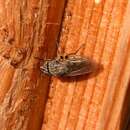ar
الأسماء في صفحات التنقل


Cluster flies (a.k.a. grass flies or attic flies) are flies of the genus Pollenia in the family Polleniidae. Unlike the more familiar blow flies, such as the bluebottle genus Phormia, they are completely harmless to human health because they do not lay eggs in human food. They are parasitic on earthworms; the females lay their eggs near earthworm burrows, and the larvae then feed on the worms. But the biology of this group is relatively poorly known and a few have been recorded from other hosts including caterpillars and bees.[13]
Cluster flies seek refuge in cold weather and find their way into attic spaces and similar areas indoors. They often emerge on warm days, and cluster at windows attempting to exit (hence the name).[14]
The typical grass fly Pollenia rudis is about 7 mm long and can be recognised by distinct lines or stripes behind the head, short golden-coloured hairs on the thorax, and irregular light and dark gray areas on the abdomen. Cluster flies are typically slow-moving.
Cluster flies have a widespread distribution. Eight species are found in Britain and 31 in Europe. Pollenia species are also numerous in Australia and New Zealand (over 30 species); they are common in North America. P. rudis has spread widely in association with humans.[15]
Cluster flies (a.k.a. grass flies or attic flies) are flies of the genus Pollenia in the family Polleniidae. Unlike the more familiar blow flies, such as the bluebottle genus Phormia, they are completely harmless to human health because they do not lay eggs in human food. They are parasitic on earthworms; the females lay their eggs near earthworm burrows, and the larvae then feed on the worms. But the biology of this group is relatively poorly known and a few have been recorded from other hosts including caterpillars and bees.
Cluster flies seek refuge in cold weather and find their way into attic spaces and similar areas indoors. They often emerge on warm days, and cluster at windows attempting to exit (hence the name).
Pollenia sp. on leaves in a forestThe typical grass fly Pollenia rudis is about 7 mm long and can be recognised by distinct lines or stripes behind the head, short golden-coloured hairs on the thorax, and irregular light and dark gray areas on the abdomen. Cluster flies are typically slow-moving.
Cluster flies have a widespread distribution. Eight species are found in Britain and 31 in Europe. Pollenia species are also numerous in Australia and New Zealand (over 30 species); they are common in North America. P. rudis has spread widely in association with humans.
Pollenia[1] este un gen de muște din familia Calliphoridae.[1]
|access-date= (ajutor)Mentenanță CS1: Nume multiple: lista autorilor (link)
Pollenia este un gen de muște din familia Calliphoridae.
Vindsflugor (Pollenia) är ett släkte av flugor som hör till familjen spyflugor. Släktets namn kommer av att flugorna ofta övervintrar inomhus, på vindar eller andra liknande utrymmen där de då ibland kan återfinnas i stort antal. Det finns 9 arter i Sverige[1].
Vindsflugor är cirka 6–10 millimeter stora, robust byggda och håriga flugor med genomskinliga vingar. Olikt många andra spyflugor har de ingen särskild metallskimmer.
Vindsflugor lägger ägg i jorden och deras larver lever som parasiter på daggmaskar. De fullbildade flugorna söker på hösten upp lämpliga övervintringsplatser, till exempel håligheter i träd men också svala vindar och andra utrymmen under taket på bostadshus och andra byggnader.
Vindsflugorna sitter stilla under övervintringen, men om det utrymme där de övervintrar tillfälligt värms upp eller om flugorna blir störda kan de vakna till och flyga omkring. Deras beteende och flygsätt är oftast lite slött och klumpigt.
Vindsflugor gör ingen skada inomhus utan söker sig ut igen till våren. Men om vindsflugor övervintrar i mycket stort antal i ett bostadshus kan de upplevs som besvärande. Råd och hjälp för att åtgärda problemet kan fås av företag som bekämpar skadedjur. Problem med vindsflugor kan förebyggas genom åtgärder för att förhindra att flugorna tar sig in i bostaden.
Vindsflugor (Pollenia) är ett släkte av flugor som hör till familjen spyflugor. Släktets namn kommer av att flugorna ofta övervintrar inomhus, på vindar eller andra liknande utrymmen där de då ibland kan återfinnas i stort antal. Det finns 9 arter i Sverige.